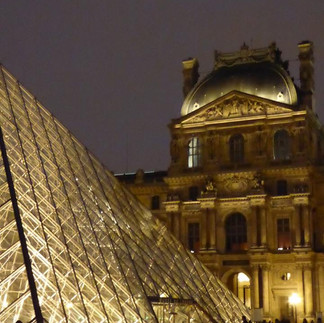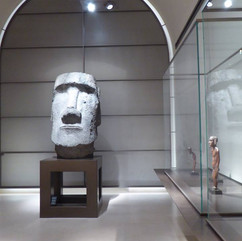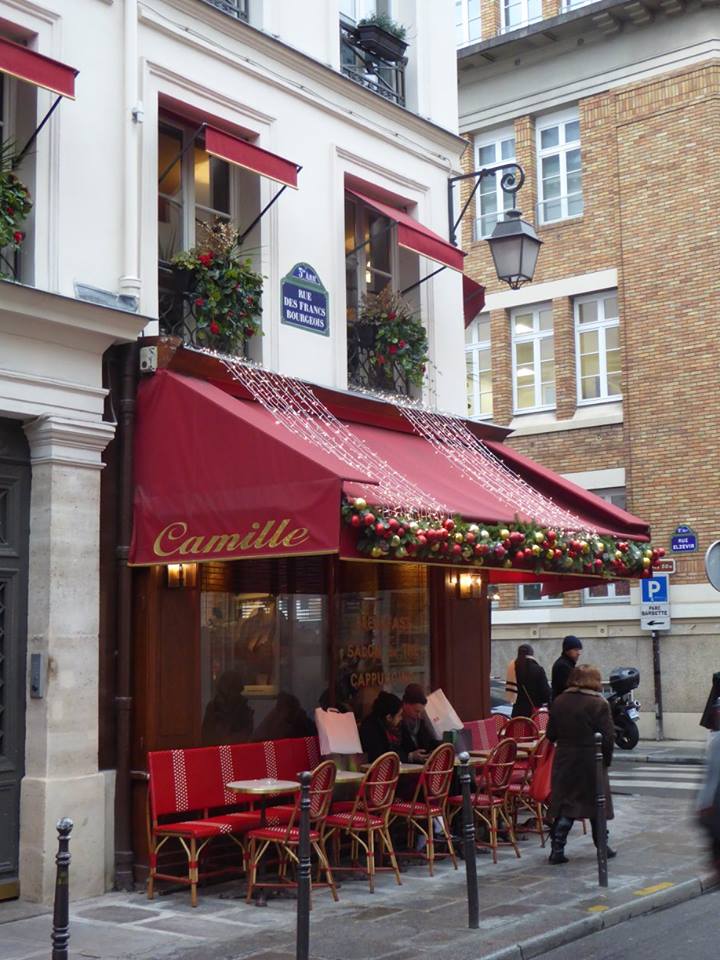A romantic city break: The best of Paris
- Karyn Farrell
- Dec 13, 2018
- 9 min read
Updated: Feb 21

* Update: New blog posts on two more recent visits to Paris can be found here and here which cover some lesser-visited spots in the city *
Paris is one of the greatest cities in the world. Fact. Everything about it is wonderful: the art, the food, the wine, the language, the people, the beautiful buildings... The list is endless. It's easy to spend hours aimlessly wandering along the banks of the Seine, stopping only for a coffee or a glass of red.
What to do: the best of Paris for a first-time explorer
Disclosure: some of the links on this site are affiliate links with companies I have chosen to partner with. If you make a purchase through these, I may receive a small commission at no extra cost to you. Thank you for your support!
Explore the city on foot
Paris has a great transport system but to get a real feel for a city, it's worth taking the time to carry out some explorations on foot. You miss so much going from point A to point B underground - the magic spots are usually found on the detours and the little side streets. I particularly love Paris in winter, and think it never looks more beautiful than on crisp, frosty days with a blue-sky backdrop. Sometimes it's hard to shake the feeling that you're on the set of a Woody Allen movie, never more so than when browsing the booksellers stalls at the quay side, and picking up some of those quintessentially Parisian-style posters.
A particularly nice walking route starts off at Pont de la Concorde. From here, walk through the beautifully manicured Tuileries gardens, until you come to Musée du Louvre at the other end. It’s a really calm space within the city and I love how it looks in winter with the flat-topped bare trees lining the symmetrical walkways. It’s also gorgeous in summer when the trees are in full leaf, offering a welcome respite from the heat.
Pretty green chairs are dotted everywhere so you can pull up a pew at one of the ponds, or sit beneath the trees and read a book. The Tuileries Gardens also houses the wonderful Musée de l’Orangerie and leads nicely onto Musée du Louvre. But first for an apéritif at Hôtel du Louvre on Rue de Rivoli.
The Pyramid du Louvre looks particularly impressive at night, lit up from within. Personally I love how the steel and glass pyramid sits comfortably alongside the classical facades of the surrounding buildings, the earliest of which dates to the 16th century. Designed by I.M. Pei and officially opened in 1989 as the new grand entrance to the museum, this structure was extremely divisive, viewed by some as an abomination of modern architecture. I think it really complements the surrounding buildings, reflecting the old in the new.
A short walk brings you to Le Marais in the 4th arrondissement with its winding medieval streets filled with bars and restaurants, boutiques, artisan shops, jewellers, galleries and museums. It’s also home to the Jewish quarter, the elegant Place des Vosges and the magnificent Hôtel de Ville.
Nighttime in Paris is a pretty special experience. That first glimpse of the shimmering lights of the Eiffel Tower brings out my inner child, no matter how many times I visit. The best viewing point is from the platform at the Trocadero. But be prepared to vie for space with the multitude of tourists looking for the perfect shot. Oh, and the constant hassle by hawkers trying to sell you light-up, plastic Eiffel Towers. Who wouldn’t want one of those, right?
Check out some of the world's most famous art works It's no secret that Paris is home to some of the best museums in the world, ones I keep coming back to again and again. There are the obvious stars: the Louvre and Musée d’Orsay, though both are becoming increasingly difficult to appreciate with the constant photography and selfie-stick action. But in saying that, if you’re interested in modern art, then you can't miss Musée d’Orsay.
Its collection of Van Goghs, Cézannes, Caillebottes, Degas, Toulouse-Lautrecs etc… is second to none. It is also home to the provocative ‘Origin of the World’ by Courbet and Manet’s ‘Dejeuner sur l’Herbe’. I can still vividly remember my first visit when I was twenty years old, feeling almost overawed by the magnitude of their collection, and being so excited to get up close and personal with some of my favourite paintings.
Just beware though - the selfie action here and in the Louvre can be at best distracting and at worst, intrusive. But, those in the know will rapidly move on from the masses posing with the Mona Lisa and pop around the corner to enjoy Leonardo’s stunning Virgin of the Rocks and Titian's heartbreaking Ecce Homo which are being completely ignored just a few feet away. Before you leave the Louvre, make sure to explore the lesser-visited rooms like the Pavillon des Sessions, a wonderful collection from the Arts of Africa, Asia, Oceania, and the Americas, some dating back to several centuries BC and some contemporary.
Paris also has the wonderful Picasso Museum and the Rodin Museum. There are Picasso museums all over Europe, including Barcelona, Antibes and Malaga, but this is one of my favourites. It houses a really comprehensive collection of his work, covering all periods – it has over 5000 pieces in all media including painting, sculpture, engravings and drawings. Not only that, it has a terrific collection of works from his contemporaries including the beautiful ‘Marguerite’. by Matisse.

The Rodin Museum is housed in a beautiful 18th century mansion, close to Les Invalides, but what makes it extra-special is the sculpture garden where you can see his iconic The Thinker, among other masterpieces. Also, there’s a interesting little back story to this museum. In the early 20th century the mansion became home to the artist. He had initially rented four of the rooms to use as a studio, but had occupied the entire building by 1911. He particularly loved the garden and had placed some of his works amidst its greenery. The building was sold to the French government in 1911 but upon condition that he granted all his sculptures, drawings, as well as his collection of antiquities to the state, it was agreed that he would be allowed to reside there until his death. And in 1916, the house became known as the Musée Rodin. It's always worth a visit. However my two favourite museums in Paris are Musée de l’Orangerie and Musée Marmottan Monet. The latter is located near the Bois de Boulogne and houses one of the city’s largest collections of Impressionist paintings, with the largest collection of Monets anywhere in the world. In 1966 the artist’s son Michel bequeathed his collection of paintings inherited from his father to this museum and they are just breathtaking. There are scenes from Paris, London, and Norway; there are stunning images of water lilies and rose gardens with a number of exquisite snow scenes which I had to drag myself away from. No photography is allowed in this museum and as a result the gallery spaces are beautiful and really calming. It’s a must-visit!
And then there’s the Musée de l’Orangerie. The curved walls hold what can only be described as Monet’s greatest masterpiece – his frieze of eight panels of the Nymphéas or Water Lilies cycle which took over the final three decades of his life. Monet donated these works to the French State in 1922, and they have been on display at the Musée de l’Orangerie since 1927, installed exactly to the artist’s specifications.
The series of paintings was inspired by the water garden at his Giverny estate in Normandy. The oval-shaped room creates a continuous frieze, and the monumental panels mean you are completely immersed in his landscape of water lilies, weeping willows and pools of water. As you move from painting to painting, the light changes; the season changes; the mood changes. The room is lit by natural light from above, also to Monet’s specification, and the works are carefully placed to take advantage of this: his sunrise scenes are strategically placed to the east of the building, and the scenes of sunset to the west. The effect is extraordinary.
And that’s not the whole Orangerie experience. They also have a terrific permanent collection featuring 146 works from the 1860s to the 1930s including paintings by Cézanne, Matisse, Modigliani and Picasso.
Sainte Chapelle, 8, Boulevard du Palais Metro: Cité or Châtelet
Sainte Chapelle, the lesser-known sister of Notre Dame, is situated close by, on the Ile de la Cité. Built in the mid 13th century, it’s a spectacular feat of Gothic architecture and of medieval engineering. Innocuous from the outside and hidden away in the grounds of the Palais de Justice, it’s truly spectacular on the interior with its soaring slender panels of stained-glass (1,113 to be exact) and its magnificent rose window. The whole effect is one of lightness and verticality. Your eyes are immediately drawn upwards, which I imagine was the religious intention. On a sunny day when the light is streaming through the windows, it’s almost a spiritual experience. They also hold concerts here, if you're lucky enough to catch one which coincides with your trip. We were lucky enough to see a performance of Vivaldi's Four Seasons here one evening before Christmas. It was a special evening though marred somewhat by the bitter cold temperatures outside which seemed to make their way inside and freeze us to our bones on the hard cathedral seats. But a takeaway mulled wine from a street-side stall soon sorted us out.
Where to stay: the best of Paris Hotel le A, 4 Rue d’Artois: Metro: Saint-Philippe-du-Roule
This is a terrific hotel which ticked every box, from the warm and friendly staff to the welcome drink on arrival. The location is excellent – only five mins from Champs-Élysées and Arc de Triomphe, and really close to two Metro stations and two lines. Décor is modern Scandi-style and we stayed in a Junior Suite, which I would recommend if you can spend a bit extra as it is worth it for the extra space. The bed was super-comfortable while the bathroom had a luxurious rain-shower and products from l’Occitane.
And I have to mention the breakfast: the hotel provides a continental buffet with crusty bread, cheese, meats, yogurt, cereal and freshly squeezed juice, and the cafetiéres of coffee are a nice touch. In addition, hot food was available to order on request (I would highly recommend their omelettes). Service came with a broad smile and a friendly chat every morning making it one of my favourite parts of the day.
Hotel Henriette is another absolute gem. I stayed there in 2019 and I wrote about it in my more recent post here
Where to eat Camille: 24, rue des Francs Bourgeois It's the day before Christmas Eve and we've been seated at the window; perfect for spying on the inhabitants of the Marais as they go about their business. Tiny tables are crammed close together and the place is full to the brim with French people, already a good sign. Menus are hand-written on a blackboard and propped up beside your table as you make your choice. Waiters float efficiently between tables in their shirts and black bow-ties, always stopping for a friendly word before moving on to the next table. The atmosphere is cosy and buzzy - we look at each other and smile.
And then came the food. Sea bass with a simple sauce vierge and duck, one of the dishes for which they are famed accompanied by a perfect dish of buttery mashed potato, all washed down by a well-chosen Côtes du Rhônes. But the star of the show had to be the dessert: tarte tatin served with a little jug of thick double cream. The waiter smiled knowingly as we greedily devoured every last bit. It's possibly one of the nicest things I've ever tasted. As romantic meals go, this one will be hard to beat.
Don Giovanni: 19 rue Francois Miron Need a break from rich French food? Then come here and stuff yourself to death with Italian food for a change. The atmosphere is fun and convivial with great food, and the staff are larger than life. Oh and a glass of Champagne (not Prosecco, actual Champagne) will set you back a mere €8.
Expect high-quality ingredients across the board including a particularly creamy mozzarella and some excellent seafood pasta but it was the Penne alla Vodka which stole the show. They also have a decent and reasonably priced Italian wine list. This is the place to come for unpretentious food at great prices in a great location.
Le Cercle Luxembourg: 1 rue Gay Lussac Located just across the street from one of the entrances into Jardin de Luxembourg, this unpretentious little bar is a perfect spot to stop for a crêpe and a beer. On a particularly Baltic day in December, this was a welcome reprieve from the cold. Service was warm and friendly and the food was great. Simple and tasty.
Practical Info:
Traveling with a group of people? Welcome Pickups offer excellent value for money and a reliable airport transfer service. Book your transfer here
If you're planning on travelling a little further afield, one of the best value sites we've used to date is Discover Cars, comparing prices across 700 suppliers.
For a greener alternative, France's main cities are very well connected by rail, with reasonably priced fares too. Trainline is my go-to site of choice for train bookings: it's user-friendly with cheaper fares than other sites. Book here.
Need to leave your bags somewhere for a few hours? For €5 per bag per day, Radical Storage conveniently has outlets all over Paris. Book in advance here.
I've written pretty extensively about Paris to date. It's one of my favourite cities of all time, and one I continue to return to. You can read my earlier posts below.
Bonnes vacances
Karyn xx










































































Need France visa from UK? Get the best help from France schengen visa to get a France visa Appointment. Know about getting France Visa UK or how to apply for France visa.